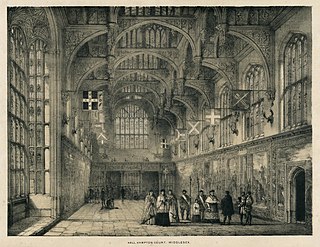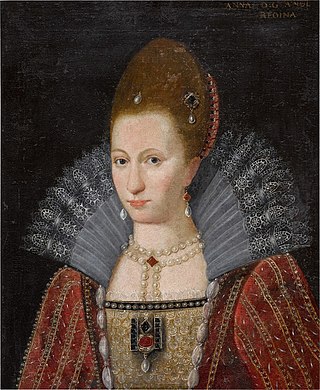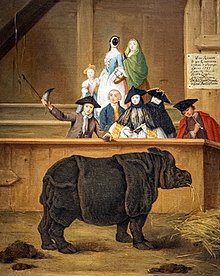
Lady Arbella Stuart was an English noblewoman who was considered a possible successor to Queen Elizabeth I of England. During the reign of King James VI and I, she married William Seymour, 2nd Duke of Somerset, another claimant to the English throne, in secret. King James imprisoned William Seymour and placed her under house arrest. When she and her husband tried to escape England, she was captured and imprisoned in the Tower of London, where she died at age 39.

Katherine Howard, Countess of Suffolk was an English court office holder who served as lady-in-waiting to the queen consort of England, Anne of Denmark.

Ludovic Stewart, 2nd Duke of Lennox and 1st Duke of Richmond, lord of the Manor of Cobham, Kent, was a Scottish nobleman who through their paternal lines was a second cousin of King James VI of Scotland and I of England. He was involved in the Plantation of Ulster in Ireland and the colonization of Maine in New England. Richmond's Island and Cape Richmond as well as Richmond, Maine, are named after him. His magnificent monument with effigies survives in Westminster Abbey.

Margaret Stuart, Scottish aristocrat and courtier in England. She served as lady-in-waiting to the queen consort of England, Anne of Denmark. She was the daughter of James Stewart, 2nd Earl of Moray, and Elizabeth Stuart, 2nd Countess of Moray. The sailor and patron of Ben Jonson, Sir Frances Stuart was her brother.
William Fowler was a Scottish poet or makar, writer, courtier and translator.

The Vision of the Twelve Goddesses was an early Jacobean-era masque, written by Samuel Daniel and performed in the Great Hall of Hampton Court Palace on the evening of Sunday, 8 January 1604. One of the earliest of the Stuart Court masques, staged when the new dynasty had been in power less than a year and was closely engaged in peace negotiations with Spain, The Vision of the Twelve Goddesses stood as a precedent and a pattern for the many masques that followed during the next four decades.
Jean Ker, Countess of Roxburghe, néeDrummond (c.1585–1643) was a Scottish courtier, serving Anne of Denmark in Scotland and England.
Juan de Tassis y Acuña, 1st Count of Villamediana, was a Spanish diplomat and official, awarded his title by king Philip III of Spain in 1603, and the General Head of Spanish Post Offices.
Sir William Herrick or Hericke was an English jeweller, courtier, diplomat and politician who sat in the House of Commons at various times between 1601 and 1622.
Lady Audrey Walsingham was an English courtier. She served as Lady of the Bedchamber to queen Elizabeth I of England, and then as Mistress of the Robes to Anne of Denmark from 1603 until 1619.
Barbara Ruthven was a Scottish courtier and favourite of Anne of Denmark, expelled from court after the death of her brother.
Dorothy Hastings was a courtier to Elizabeth I of England and Anne of Denmark
John Elphinstone of Selmes and Baberton (1553-1614) was a Scottish landowner and courtier.

Prince Henry's Welcome at Winchester was a masque produced by Anne of Denmark and performed in 1603 at Winchester on a day between 11 and 17 October.

The jewels of Anne of Denmark (1574–1619), wife of James VI and I and queen consort of Scotland and England, are known from accounts and inventories, and their depiction in portraits by artists including Paul van Somer. A few pieces survive. Some modern historians prefer the name "Anna" to "Anne", following the spelling of numerous examples of her signature.

Peter Sanderson was an Edinburgh tailor who worked for Anne of Denmark wife of James VI of Scotland.

The Masque of Indian and China Knights was performed at Hampton Court in Richmond, England on 1 January 1604. The masque was not published, and no text survives. It was described in a letter written by Dudley Carleton. The historian Leeds Barroll prefers the title, Masque of the Orient Knights.
Christophe de Harlay, Count of Beaumont (1570–1615) was a French politician and diplomat who served as ambassador to England.

The coronation of James I and his wife Anne as King and Queen of England and Ireland was held on 25 July 1603 at Westminster Abbey. James had reigned as King James VI of Scotland since 1567. Anne was anointed and consecrated with prayers alluding to Esther, the Wise Virgins, and other Biblical heroines. It was the first coronation to be conducted in English instead of Latin. A planned ceremonial Royal Entry to London was deferred until 15 March 1604.

Peter Rannald was a Scottish tailor who worked for Anne of Denmark, the wife of James VI of Scotland.
















